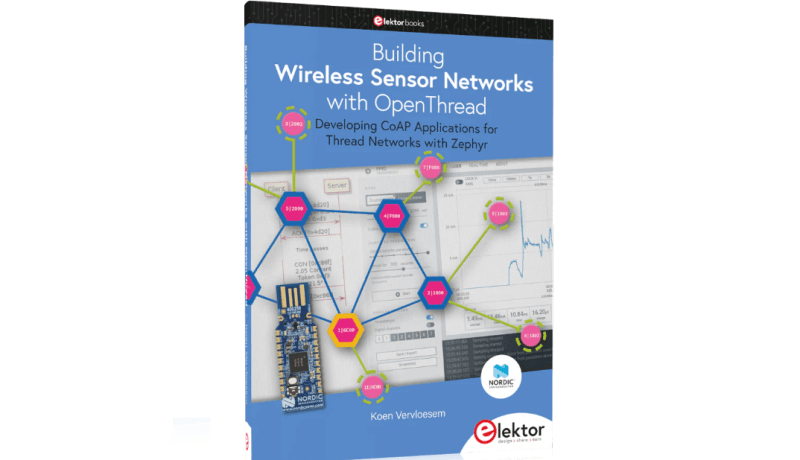More Than a Book: Building Wireless Sensor Networks with OpenThread
May 03, 2024
on
on

Elektor's newly released book "Building Wireless Sensor Networks with OpenThread" covers methods of setting up open-source sensor networks for the main microcontroller platforms like Raspberry Pi and ESP32. It’s not just a book, though, as the value of the "words and pictures" is due to two powerful adjuncts. For hardware, there’s the Nordic Semiconductor nRF52840 module included in the product bundle. For software, it’s mainly the free “Zephyr” RTOS propagated by the Linux Foundation.

First, we have the book by top author Koen Vervloesem. He presents a massive amount of background information as well as get-you-going examples for building and programming your own networks to read sensors of all sorts. It also shows practical setup info and applications using the nRF52840 dongle bundled with the book. Although the book moves at speed, the coverage of OpenThread and Zephyr in particular remains thoroughgoing from the Introduction right up to the Appendix. Koen’s style is lucid and to the point, with a systematic buildup from theory to hands-on construction of the example projects, and programming. Check out the book’s Contents pages and a free-read excerpt here.

Second, the Nordic Semiconductor nRF52840 module included with the book is an excellent little helper for those seeking an easy way to connect an embedded system to various types of open-source networks designed to connect sensors. Elektor is honored to be able to include this module through an exclusive collaboration program set up with Nordic Semiconductor. All the nRF52840’s hardware and programming options are discussed in detail in the book to prepare for must-know applications like the monitoring of extremely low power sensors and other devices in any OpenThread network you have access to, or have created yourself.

Third, for the software “ingredients” that went into the publication, there is Zephyr as the main driver, but also CoAP, Wireshark, and several utilities from Nordic. If you want to get your Thread application’s power consumption as low as possible, you’ll have to take advantage of Zephyr’s power-management API. This allows you to use the power saving features of the SoC and other devices, such as connected sensors. Your code then reads a sensor measurement, sends the data over the Thread network, suspends the sensor, sleeps, wakes up, resumes the sensor, and starts the whole cycle again. You see, “power” does not always equate to lots of current in wires — it’s actually your ability to read and control micro-amp and nano-amp sensors in (very) remote places, with accuracy and confidence, all thanks to OpenThread.

First, we have the book by top author Koen Vervloesem. He presents a massive amount of background information as well as get-you-going examples for building and programming your own networks to read sensors of all sorts. It also shows practical setup info and applications using the nRF52840 dongle bundled with the book. Although the book moves at speed, the coverage of OpenThread and Zephyr in particular remains thoroughgoing from the Introduction right up to the Appendix. Koen’s style is lucid and to the point, with a systematic buildup from theory to hands-on construction of the example projects, and programming. Check out the book’s Contents pages and a free-read excerpt here.

Second, the Nordic Semiconductor nRF52840 module included with the book is an excellent little helper for those seeking an easy way to connect an embedded system to various types of open-source networks designed to connect sensors. Elektor is honored to be able to include this module through an exclusive collaboration program set up with Nordic Semiconductor. All the nRF52840’s hardware and programming options are discussed in detail in the book to prepare for must-know applications like the monitoring of extremely low power sensors and other devices in any OpenThread network you have access to, or have created yourself.

Third, for the software “ingredients” that went into the publication, there is Zephyr as the main driver, but also CoAP, Wireshark, and several utilities from Nordic. If you want to get your Thread application’s power consumption as low as possible, you’ll have to take advantage of Zephyr’s power-management API. This allows you to use the power saving features of the SoC and other devices, such as connected sensors. Your code then reads a sensor measurement, sends the data over the Thread network, suspends the sensor, sleeps, wakes up, resumes the sensor, and starts the whole cycle again. You see, “power” does not always equate to lots of current in wires — it’s actually your ability to read and control micro-amp and nano-amp sensors in (very) remote places, with accuracy and confidence, all thanks to OpenThread.
Subscribe
Tag alert: Subscribe to the tag Zephyr and you will receive an e-mail as soon as a new item about it is published on our website! Read full article
Hide full article





Discussion (0 comments)